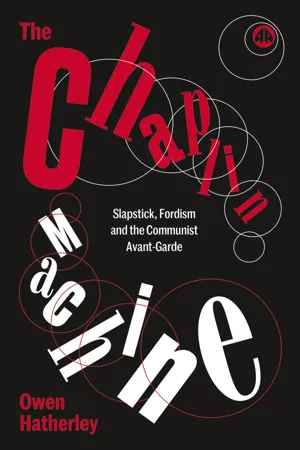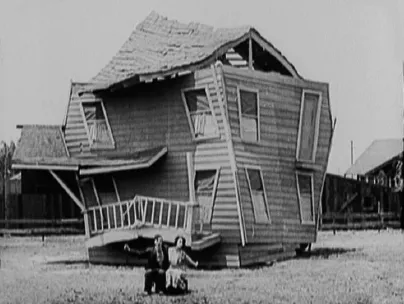
- 240 pages
- English
- ePUB (mobile friendly)
- Available on iOS & Android
eBook - ePub
About this book
Could Buster Keaton have starred inBattleship Potemkin? Did Trotsky plan to write the great Soviet comedy? And why did Lenin love circus clowns? The Chaplin Machine reveals the lighter side of the Communist avant-garde and its unlikely passion for American slapstick. Set against the backdrop of the great Russian revolutionary experiment, Owen Hatherley tells the tragic-comedic story of the cinema, art and architecture of the early 20th Century and spotlights the unlikely intersections of East and West.
Frequently asked questions
Yes, you can cancel anytime from the Subscription tab in your account settings on the Perlego website. Your subscription will stay active until the end of your current billing period. Learn how to cancel your subscription.
No, books cannot be downloaded as external files, such as PDFs, for use outside of Perlego. However, you can download books within the Perlego app for offline reading on mobile or tablet. Learn more here.
Perlego offers two plans: Essential and Complete
- Essential is ideal for learners and professionals who enjoy exploring a wide range of subjects. Access the Essential Library with 800,000+ trusted titles and best-sellers across business, personal growth, and the humanities. Includes unlimited reading time and Standard Read Aloud voice.
- Complete: Perfect for advanced learners and researchers needing full, unrestricted access. Unlock 1.4M+ books across hundreds of subjects, including academic and specialized titles. The Complete Plan also includes advanced features like Premium Read Aloud and Research Assistant.
We are an online textbook subscription service, where you can get access to an entire online library for less than the price of a single book per month. With over 1 million books across 1000+ topics, we’ve got you covered! Learn more here.
Look out for the read-aloud symbol on your next book to see if you can listen to it. The read-aloud tool reads text aloud for you, highlighting the text as it is being read. You can pause it, speed it up and slow it down. Learn more here.
Yes! You can use the Perlego app on both iOS or Android devices to read anytime, anywhere — even offline. Perfect for commutes or when you’re on the go.
Please note we cannot support devices running on iOS 13 and Android 7 or earlier. Learn more about using the app.
Please note we cannot support devices running on iOS 13 and Android 7 or earlier. Learn more about using the app.
Yes, you can access The Chaplin Machine by Owen Hatherley in PDF and/or ePUB format, as well as other popular books in History & Social History. We have over one million books available in our catalogue for you to explore.
Information
1
Constructing The Chaplin Machine:
The Constructivist International Encounters the American Comedians
The Constructivist International Encounters the American Comedians
If one considers the dangerous tensions which technology and its consequences have engendered in the masses at large – tendencies which at critical stages take on a psychotic character – one also has to recognise that the same technologisation has created the possibility of psychic immunisation against such psychoses. It does so by means of certain films in which the forced development of sadistic fantasies or masochistic delusions can prevent their natural and dangerous maturation in the masses. Collective laughter is one such pre-emptive and healing outbreak of mass psychosis. The countless grotesque events consumed in films are a graphic indication of the dangers threatening mankind from the repressions implicit in civilisation. American slapstick comedies and Disney films trigger a therapeutic release of unconscious energies. Their forerunner was the figure of the eccentric. He was the first to inhabit the new fields of action opened up by film – the first occupant of the newly built house. This is the context in which Chaplin takes on historical significance.
Walter Benjamin, ‘The Work of Art in the Age of its Technological Reproducibility’, 19361
For Walter Benjamin, the new landscape of the ‘Second Industrial Revolution’, with its mass production factories, new means of transport and communication, and its increased geographical spread and its concentration of population and labour, is incarnated as a ‘newly built house’ – but a newly built house which, we can expect, resembles the theatrical constructions of Vesnin and Popova, or, as we shall soon see, of Buster Keaton – a house full of trapdoors, mass-produced, jerry-built or prefabricated, but with a new spatial potential, where its multiple pitfalls can be faced without incurring real pain, real physical damage – traversed, if not transcended. The person that can live in it is the Soviet figure of the Eccentric, who has adapted himself to the precipitous new landscape, and has learned to laugh at it; in turn the audience, who may well live in these new houses too, learn to live in them in turn. To get some notion of what the newly built house is like, we could turn to the one in Buster Keaton’s One Week (1920): a prefabricated house whose pieces are assembled in the wrong order, which is alternately dragged along a road and knocked down by a train, but which in between provides a series of vivid and joyous surprises for its inhabitants and the audience. Alternatively, it could be like the house in Lev Kuleshov’s Americanist gold-rush melodrama By The Law (1926), another minimal, wooden construction placed in the barren Western expanse, which begins as a sweet petit-bourgeois homestead but soon becomes consecutively an execution chamber and a flooded, marooned wreck, left desolate and hopelessly bleak.
Comic Anti-Humanism
According to Benjamin, the Eccentric is Chaplin. But what sort of a man can live in this new house? Is Chaplin a man at all? In Movies for the Millions, a 1937 study of the popular consumption of cinema, the critic Gilbert Seldes made the observation, in the context of a discussion of the comic film, that there was something uncanny about Charles Chaplin. Several pages after an encomium to Chaplin’s genius (as ‘the universal man of our time’) he remarks, almost as an aside, ‘(W.C.) Fields is human. Chaplin is not’. Chaplin’s inhumanity is then defined as a consequence of this universalism, combined with a resemblance to a doll, an automaton.

Buster Keaton’s newly built house

A house stranded, in Lev Kuleshov’s By The Law
He is not [human] because perfection is not human and Chaplin achieves perfection. A French critic has said that in his early works Chaplin presented a marionette and in his later masterpieces endowed that marionette with a soul. That is one way of putting it. It is also true that he created a figure of folklore – and such figures, while they sum up many human attributes, are far beyond humanity themselves.2
This provides an interesting contrast with the more familiar idea of Chaplin as a mawkish sentimentalist. ‘Chaplin’ is not a human being, and is not a realistically depicted subject – he is both machine and archetype. In this he serves as an obvious paradigm for the avant-garde. In his earlier films (principally those made for the Essanay, Mutual and First National studios in the late 1910s, before the character of the ‘little Tramp’ was finalised, humanised) ‘Chaplin’ is involved, largely, in everyday situations, albeit in dramatic versions. He is a cleaner in a bank, he is a stroller in a park, he is a petty criminal, he is pawning all his possessions. This universal everyday is made strange, through use of the accoutrements of the everyday for purposes other than those intended, and through the peculiarly anti-naturalistic movements of Chaplin’s own body. Chaplin wrote the preface to Movies for the Millions (where he uses the opportunity to denounce the Hays code), so we can assume he had no particular problem with being branded inhuman (or sur-human). Yet however odd they seem in this relatively mainstream study, Seldes’ observations were not new. Here we will turn to the avant-garde takes on Chaplin. The field is huge, ranging from El Lissitzky and Ilya Ehrenburg’s Veshch-Gegenstand-Objet to Iwan Goll, from Erwin Blumenfeld to Fernand Léger; but here we will concentrate on the accounts of Viktor Shklovsky, Oskar Schlemmer, the Soviet magazine Kino-Fot and Karel Teige.
The reception of Chaplin by the Soviet and Weimar avant-garde from the early 1920s onwards3 hinges precisely on a dialectic of the universal and the machinic. Viktor Shklovsky edited a collection of essays on Chaplin in Berlin in 1922, and in Literature and Cinematography, published in the USSR the following year, he devotes a chapter to Chaplin; in fact, he is the only ‘cinematographer’ mentioned by name in this dual study of literature and film. Shklovsky describes this early use of multiple identities as ‘a manifestation of the need to create disparities, which compels a fiction writer to turn one of his images into a permanent paragon (a yardstick of comparison) for the entire work of art.’4 In this sense, then, Chaplin’s universalism would seem to be a means of enabling the other characters, or the events in the film, to take place, giving them centre stage. This doesn’t at all tally with the idea of Chaplin as unique ‘star’, and clearly suggests Shklovsky was only familiar with the short films preceding the feature The Kid (1921), where the tramp character emerged fully developed. The remarks that follow, however, are more insightful:
Chaplin is undoubtedly the most cinematic actor of all. His scripts are not written: they are created during the shooting [. . .] Chaplin’s gestures and films are conceived not in the word, nor in the drawing, but in the flicker of the gray-and-black shadow [. . .] he works with the cinematic material instead of translating himself from theatrical to film language.5
Chaplin is immanent to cinema, and this is what makes him interesting for Shklovsky’s purposes: formulating a theory unique to film as an art form, disdaining the ‘psychological, high society film’6 which merely imposes theatre upon a new, radically different art. Chaplin moves in a new way, through a new space.
Shklovsky’s short discussion of Chaplin includes two observations which, as we will see, are common in the avant-garde’s reception of his work, which are to do with how the body of the Chaplin-machine moves through cinematic space. First, again, we have Chaplin as machine, something about which Shklovsky is initially rather tentative: ‘I cannot define right now what makes Chaplin’s movement comical – perhaps the fact that it is mechanised.’ Similarly, this movement – mechanised or not – is something which immediately sets him apart from the other protagonists in the films, which marks him out from the ordinary run of humanity. ‘Chaplin’s ensemble moves differently than its leader.’ Shklovsky claims also that Chaplin is an artist who bares his devices, something that would be picked up over a decade later in Brecht’s ‘V-Effects of Chaplin’.7 More specifically, a baring of the ‘purely cinematic essence of all the constituents in his films’ occurs. This is done partly through the avoidance of intertitles (and, he notes, one never sees Chaplin move his lips to simulate speech), and partly through a series of devices physical or technical: ‘falling down a manhole, knocking down objects, being kicked in the rear’. So, in Shklovsky’s brief, early discussion of Chaplin we find three principal elements which are usually ascribed to the products of the avant-garde: a sort of impersonal universalism, a human being who isn’t a ‘subject’, and an alien element thrown into the everyday; a mechanisation of movement; and the baring of technical devices.
An instructive example of this correspondence being put to use, although not a cinematic one, can be found in the Bauhaus master Oskar Schlemmer’s Triadic Ballet, which shows the influence of these three elements: figures which, as in the Commedia dell’arte, are (to put it in Eisenstein’s terms) ‘types’, not subjects; a focus on mechanisation (here taken much further, with the costumes seemingly borrowing from the forms of ball-bearings, lathes, spinning tops and other toys); and an acting style which makes the construction of gesture obvious, rather than concealed. It is unsurprising, then, that Schlemmer can be found making similar remarks about Chaplin. In a Diary entry of September 1922, written while formulating the Triadic Ballet, he writes of a preference for ‘aesthetic mummery’ as opposed to the ‘cultic soul dance’ of communitarian, ritualistic forms of dance. Schlemmer argues for an aesthetic of artifice and mechanised movement:
The theatre, the world of appearances, is digging its own grave when it tries for verisimilitude: the same applies to the mime, who forgets that his chief characteristic is his artificiality. The medium of every art is artificial, and every art gains from recognition and acceptance of its medium. Heinrich Kleist’s essay Uber das Marionettentheater offers a convincing reminder of this artificiality, as do ETA Hoffmann’s Fantasiestücke (the perfect machinist, the automata). Chaplin performs wonders when he equates complete inhumanity with artistic perfection.8
The automaton, the machine, artifice: Chaplin is seen as a culmination of a Romantic tendency to create strange, uncanny, inhuman machines that resemble human beings. Mechanisation is accordingly seen as something linked as much with dance and comedy as with factory work – or more specifically, dance and comedy provide a means of coming to terms with the effects of factory work and the attendant proliferation of machines. Schlemmer continues: ‘life has become so mechanised, thanks to machines and a technology which our senses cannot possibly ignore, that we are intensely aware of man as a machine and the body as a mechanism.’ Schlemmer claims that this then leads to two only seemingly competing impulses: a search for the ‘original, primordial impulses’ that apparently lie behind artistic creativity on the one hand, and an accentuation of ‘man as a machine’ on the other. By merging the ‘Dionysian’ dance with ‘Apollonian’ geometries, Schlemmer claims the Triadic Ballet will provide some sort of yearned-for synthesis between the two. Although he does not acknowledge this, it is possible that Chaplin’s combination of mechanisation and sentiment provides a similar synthesis. Chaplin is the machine that cries.
This has a great deal in common with Walter Benjamin’s anatomy of the ‘Chaplin-machine’ in his notes for a review of The Circus (1928), where Chaplin is both an implement and a marionette, noting both that he ‘greets people by taking off his bowler, and it looks like the lid rising from the kettle when the lid boils over’; and that ‘the mask of non-involvement turns him into a fairground marionette’.9 Benjamin implies something deeper here, that this is a ‘mask’ of sanguine inhumanity, under which something more poignant and sophisticated is at work. Another of Benjamin’s observations merges Shklovsky’s positing of something immanently cinematic about Chaplin with the notion that his movement is machinic – in fact, his motion is that of the cinema itself. In a 1935 fragment he notes that the film is based on a succession of discontinuous images, in which the assembly line itself is represented. Chaplin incarnates this process.
He dissects the expressive movements of human beings into a series of minute innervations. Each single movement he makes is composed of a series of staccato bits of movement. Whether it is his walk, the way he handles his cane, or the way he raises his hat – always the same jerky sequence of tiny movements applies the law of the cinematic image sequence to human motorial functions. Now, what is it about such behaviour that is distinctively comic?10
Shklovsky suggests tentatively that it is this machinic movement itself which is comic, that Chaplin is funny precisely because he is mechanised, in which perhaps the audience detects the process at work in the film in the actions onscreen, or perhaps recognise their own increasing integration in the factories where most of them work into an ever-more mechanised capitalism, and are made to laugh at it to dispel resentment and tension. The tension, trite as it may sound, appears to be between machinic movement and personal pathos – but in the process the pathos itself may become machinic.
Meanwhile, Schlemmer’s brand of Romantic-inflected artis...
Table of contents
- Cover
- Title Page
- Copyright
- Contents
- Introduction: Americanism and Fordism – and Chaplinism
- 1. Constructing the Chaplin Machine: The Constructivist International Encounters the American Comedians
- 2. Red Clowns to the Rescue: Biomechanics in Film, Factory and Circus
- 3. No Rococo Palace for Buster Keaton: Architectures of Americanism
- 4. The Rhythm of Socialist Construction: Soviet Sound Film and the Creation of an Industrial Economy
- Conclusion: Life is getting jollier, Comrades!
- Acknowledgements
- Notes
- Index